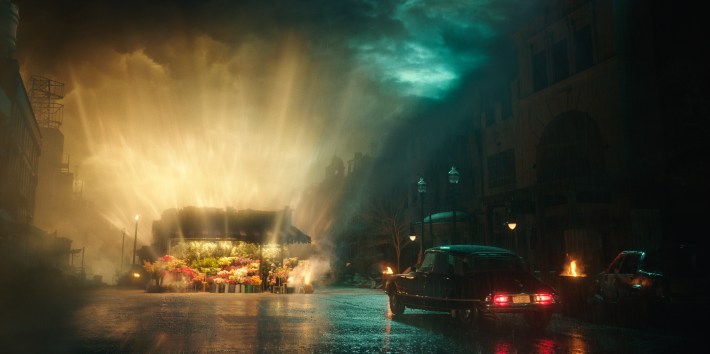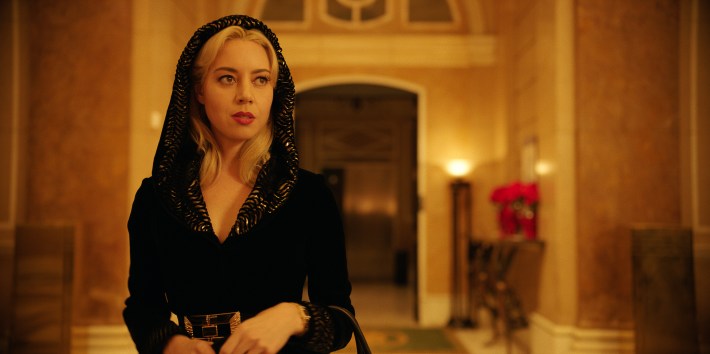Francis Ford Coppola’s strange film Megalopolis, which premiered in theaters this weekend, has been extremely divisive. Even if you think you’ll hate it, I think it’s worth seeing. It’s a spectacle that might be the last of its kind.
I truly don’t think that Megalopolis is all that difficult to understand, but the promotional materials are also not very explanatory, and the film sort of dumps you in without much of an explanation. This is a story about Cesar Catilina (Adam Driver), the head of the city of New Rome’s “Design Authority” and an architect who has recently won a Nobel Prize and gained the power to stop time. The fact that he can stop time is not that big of a deal. As the inventor of the new building material called Megalon, he’s been battling Franklin Cicero (Giancarlo Esposito), the mayor of New Rome, to build his Megalopolis, which he envisions as a utopia, in the middle of New Rome. Their relationship continues to degrade as Cicero’s daughter, Julia Cicero (Nathalie Emmanuel), becomes Catilina’s apprentice.
Further dragging Catilina down are the Pulcher siblings, Clodio (Shia LaBeouf) and his sisters Clodia, Claudette and Claudine, who are wealthy socialites whom the film repeatedly emphasizes are sleeping with each other. Clodio, Catilina’s cousin, sees him as a rival for the inheritance of their banker uncle, Hamilton Crassus III (Jon Voight). Crassus has also recently married Catilino’s former mistress, Wow Platinum (Aubrey Plaza), who is desperately scrabbling for some form of power.
The movie does have a pretty straightforward plot, but it is mostly about Caesar and Cicero’s circular arguments about what makes a utopia and whether it is worth striving for. But there’s also many tangents: There’s a thirty minute subplot about a pop star embroiled in a sex scandal that features two full songs and is totally irrelevant to the plot. For every twenty minute sequence where Caesar and Julia talk about art and society and fall in love, there was a plot development that made me mutter “what the fuck is happening.” There's a gladiatorial carriage race in Madison Square Garden.
It’s baffling to watch, but I admire its earnestness and its ambition. If nothing else, it’s a movie worth seeing for an absolutely committed performance from Aubrey Plaza, who plays Wow Platinum like a caged lion. This movie made me truly believe that Plaza is one of the best actresses of her generation.
This is clearly an old man’s last great message to the world (it ends with a pledge of allegiance to humanity; it is not a subtle film). It’s a kind of big budget movie that hardly gets made anymore, and for reasons that are obvious: Coppola self financed Megalopolis to the tune of $120 million, and it earned $4 million over the weekend. Even while budgets for blockbuster films balloon—Deadpool and Wolverine had a budget of $200 million—the money available for anything outside the mainstream has shrunk. While I’m lucky enough to live in New York, where everything hits theaters for at least a couple of days, even crowd pleasers like Best Picture winner Everything, Everywhere, All At Once had to scrape its way into a wide release.

In a move that has made the fandom-brained mad at him for years, Martin Scorsese pointed out the unfortunate dwindling landscape for movies in an op-ed for the New York Times in 2019.
“Why not just let superhero films and other franchise films be? The reason is simple. In many places around this country and around the world, franchise films are now your primary choice if you want to see something on the big screen. It’s a perilous time in film exhibition, and there are fewer independent theaters than ever,” he wrote. “The equation has flipped and streaming has become the primary delivery system. Still, I don’t know a single filmmaker who doesn’t want to design films for the big screen, to be projected before audiences in theaters.”
Francis Ford Coppola comes from the same cohort as Scorsese, and is from a generation of filmmakers for whom showing their movies in a theater was a foregone conclusion. While Scorsese has had a few of his films financed by Netflix—films I wish I could have seen in a theater—Coppola has been disillusioned by the studio system entirely, opting instead to sell a portion of his vineyard to self finance this bizarre film.

Like Catilina, Coppola is someone who experienced a lot of success early. While Catilina ends Megalopolis empowered to make his utopia a reality, Coppola has lived in the shadow of his explosive early works like The Godfather and Apocalypse Now. As his work got more personal and more experimental, audiences recoiled. The only reason why The Godfather III exists is because Coppola’s passion project One From the Heart tanked, leaving Coppola in debt. As the years went on, he became less and less interested in making movies in order to make money; instead, he’s been grasping towards some ideal of cinema itself, a process that involves telling Aubrey Plaza “In the next take, you’re a spider.” He is a kind of filmmaker who comes to set without fully formed ideas, asking his actors to improvise the movie along with him as he goes. At this point in time, studios seem especially unwilling to finance a hundred million dollar experiment. In order to get Megalopolis made and shown in a theater as it was intended to be seen, you kind of just have to be Francis Ford Coppola, and there’s only one of him.
It’s probably really good that we no longer let young men go to warzones to shoot movies in grueling productions that last over a year; one of the flaws of auteur theory is that it valorizes the idea of a “great man” who is enabled to hurt other people in the name of great art. I’m glad that that style of filmmaking is widely extinct, but I also long for the kind of art that level of freedom over a production creates. If Megalopolis is the last peek into the mind of this weird crank, then it’s a lovely send off. I doubt I’ll ever see anything like it ever again.


